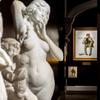The Art of Teaching: William Merritt Chase
- June 10, 2020 14:35
The canvasses of American master William Merritt Chase (1849-1916) are a reflection of the man — full of confidence and charisma with an unwavering positivity in each and every brush stroke. It was these very characteristics that made the American Impressionist one of the most important artists of his generation. Yet, it was not only his contributions on canvas that earned him the moniker, but also his work in the classroom. Chase once said: "I believe I am the father of more art children than any other teacher." And indeed he counted many of the great American modernists among his pupils, including Georgia O'Keeffe, Edward Hopper, George Bellows and Rockwell Kent.
Chase’s work as a teacher forever altered the fabric of American art history. The revered Impressionist painter was also a leader in reviving the art of the pastel, as well as a well-known proponent of the Old Masters. He knew how to draw and ensured that his students did, too — it was an instinct that extended back to Munich where he had himself been taught. He chose to study in the German city because he purportedly believed it would have fewer distractions than Paris, which was by far the more fashionable choice. The selection is a telling indication of his personality and his drive, even so early in his career.
Upon his return from Europe in the summer of 1878, Chase set about to create a distinctly American form of art that was rooted in the Old Masters, yet still distinctly modern. To augment his income during these early years of his career, he began to teach at the Art Students League of New York in 1878, beginning an over 20-year relationship with the institution. He also took on a number of private students, including the famed Realist painter Dora Wheeler in 1879.
In the years that followed, his teaching repertoire grew; he had an affinity for the classroom, and he would continue to teach throughout his career, even when his fame and wealth no longer necessitated the extra income. His reputation as a teacher quickly spread among students, and he became the most highly acclaimed and sought after educator of his day.
He continued to teach at the Art Students League for many years (1878-96 and 1907-12), and also at the Brooklyn Art School and the Chicago Art Institute (1897), and the Pennsylvania Academy of Fine Arts (1897-1909). He held summer classes in California, England, Italy, Belgium, Holland and Spain, and taught for eleven summers at Shinnecock. Perhaps most importantly, he also founded the Chase School (later the Parsons School of Design) in 1896, ensuring his legacy of promoting and cultivating the arts among aspiring young talent.
He offered summer classes at Shinnecock between 1891 and 1902, and in the early 1900s he accompanied groups of students to Europe. During this time, Chase also managed to remain active as a painter. He helped to establish the Society of American Artists and became its president in 1880. His own painting style remained representational, rooted in the academic and impressionist styles that he was taught and helped develop. Yet, Chase instilled an appreciation of technique and aesthetics in an entire generation of modernists such as Arthur B. Carles, Georgia O’Keeffe and Joseph Stella, setting the groundwork for American modernism. As the Chicago Post once declared, "William Merritt Chase's teaching, like the British drumbeat, is heard round the world."
Aside from the careers of his many students, some of the most fascinating relics of Chase’s career as a teacher are the paintings that he composed during lessons. Chase often led his students on trips outdoors to compose works en plein air, while also occasionally demonstrating his technique by dashing off a composition. These paintings can be identified within his oeuvre by the artist's signature, "Chase," rather than the more formal "Wm. M. Chase" that he generally used. According to Ronald Pisano in his catalogue raisonné of the artist's works, "[Chase] is reputed to have thrilled students when within minutes of beginning a work he would capture the essence of the subject before him."
About M.S. Rau:
M.S. Rau has spent more than 100 years earning the trust of discerning collectors worldwide. Located in the heart of New Orleans’ historic French Quarter, our peerless showroom houses one of the world’s most extensive and stunning collections of museum-quality fine art by artists such as Claude Monet and William Bouguereau, 18th- and 19th-century antiques and breathtaking jewelry, including rare colored diamonds.






100x100_c.jpg)














